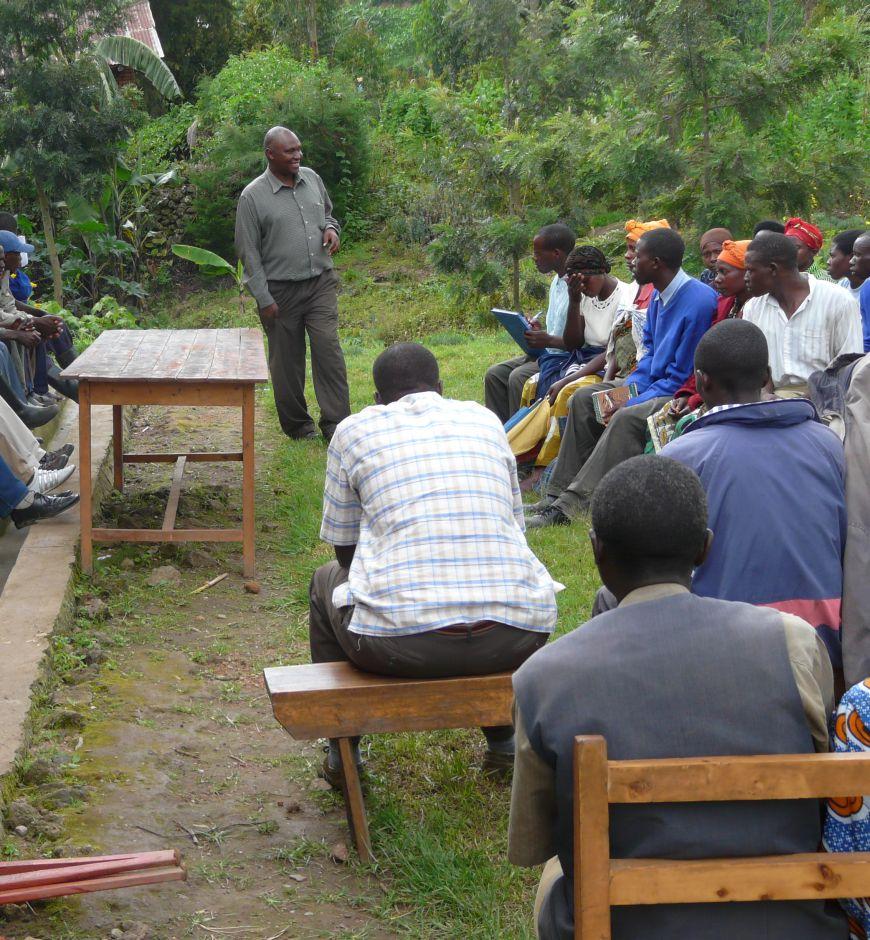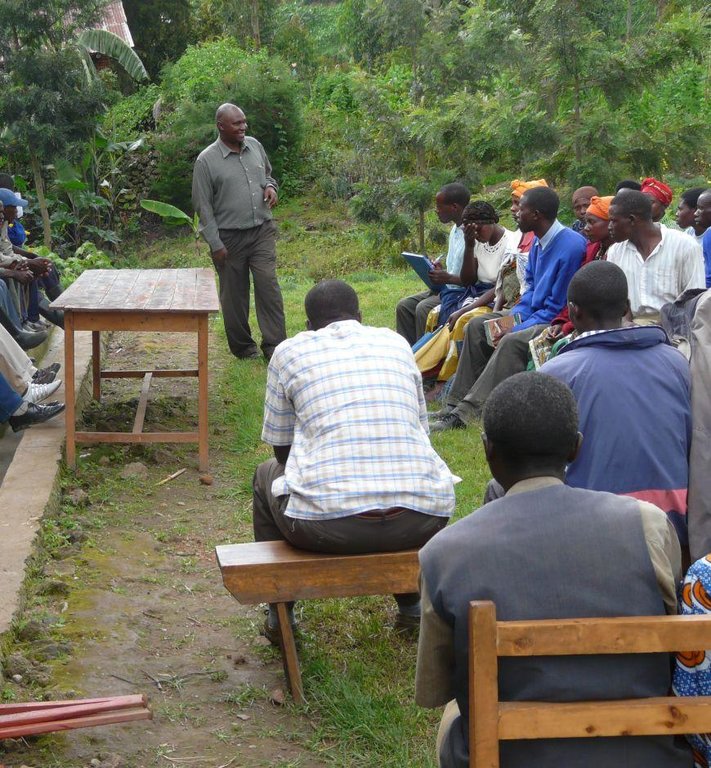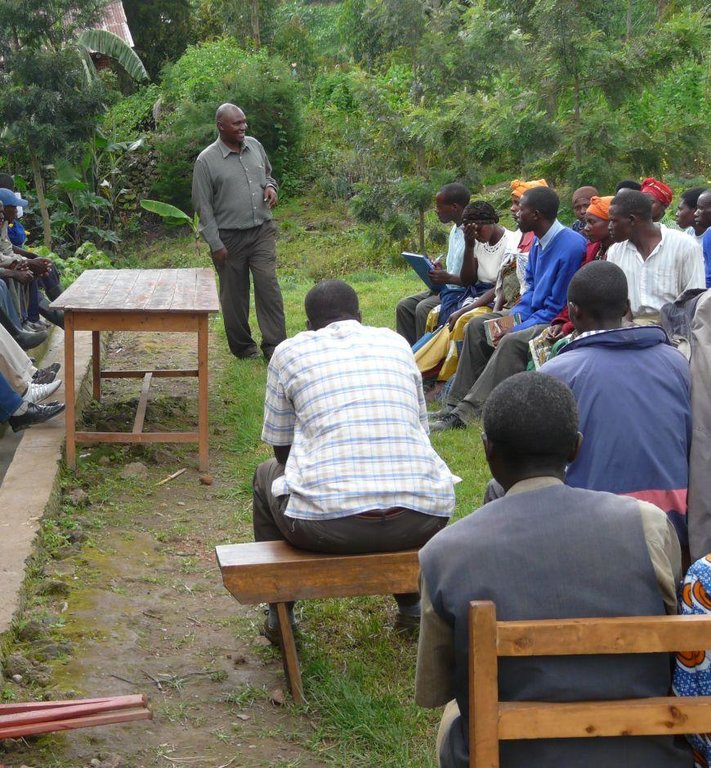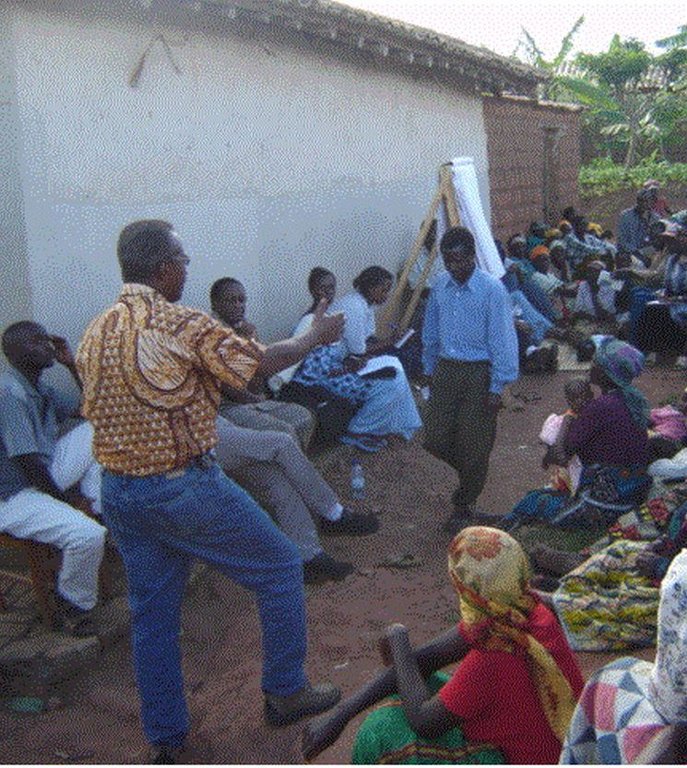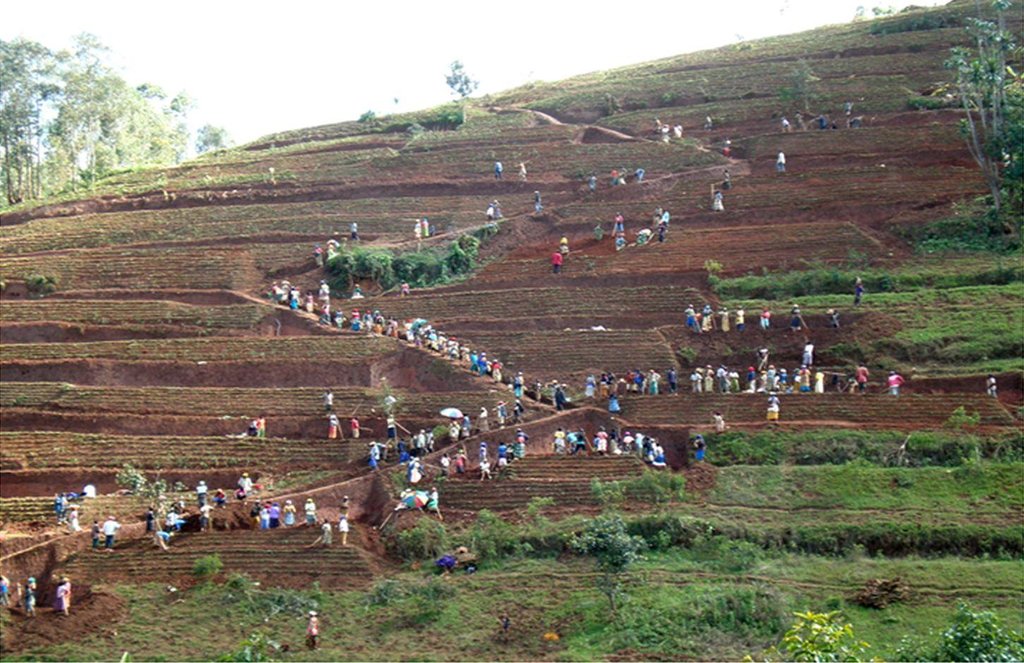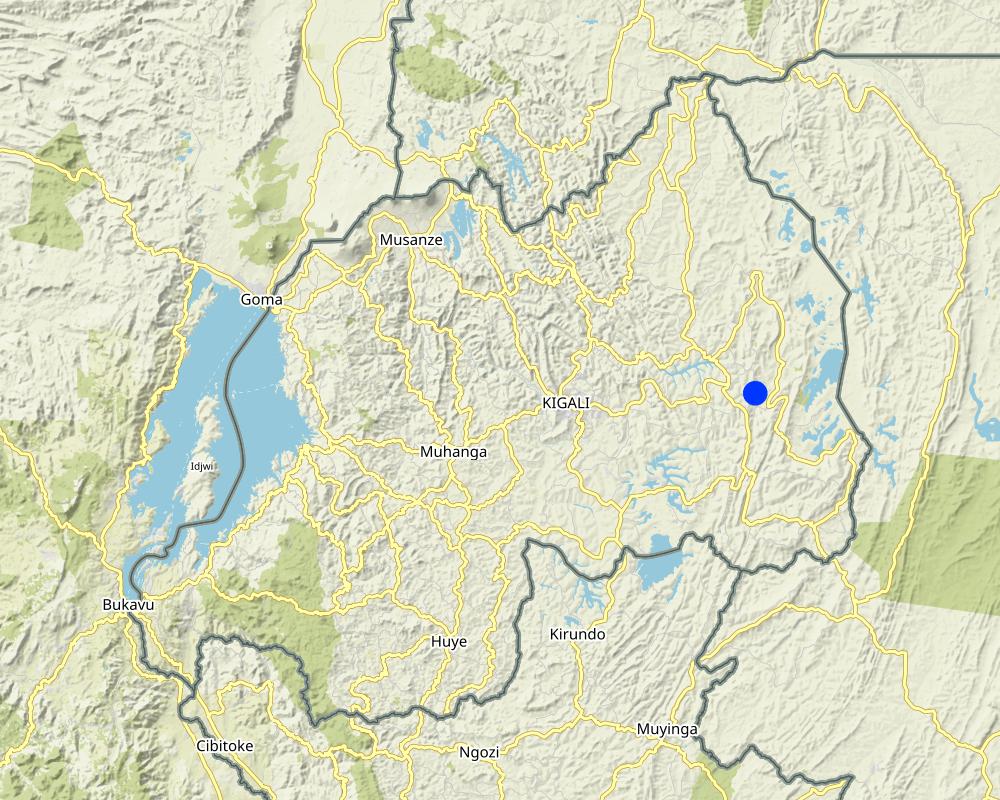Top down approach [卢旺达]
- 创建:
- 更新:
- 编制者: Desire Kagabo
- 编辑者: –
- 审查者: David Streiff, Joana Eichenberger
Amabwiriza aturutse ibukuru
approaches_2465 - 卢旺达
查看章节
全部展开 全部收起1. 一般信息
1.2 参与方法评估和文件编制的资源人员和机构的联系方式
SLM专业人员:
有助于对方法进行记录/评估的项目名称(如相关)
The Transboundary Agro-ecosystem Management Project for the Kagera River Basin (GEF-FAO / Kagera TAMP )有助于对方法进行记录/评估的机构名称(如相关)
Rwanda Agriculture Board (Rwanda Agriculture Board) - 卢旺达有助于对方法进行记录/评估的机构名称(如相关)
FAO Food and Agriculture Organization (FAO Food and Agriculture Organization) - 意大利1.3 关于使用通过WOCAT记录的数据的条件
(现场)数据是什么时候汇编的?:
01/01/2011
编制者和关键资源人员接受有关使用通过WOCAT记录数据的条件。:
是
1.4 SLM技术问卷的参考
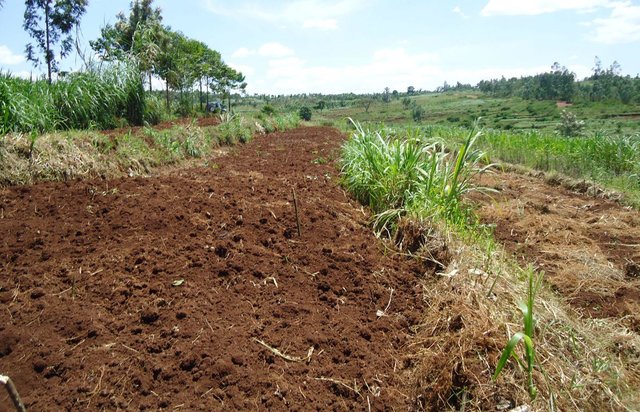
Radical Terraces [卢旺达]
Locally referred to as ‘radical terracing’, the method involves earth moving operations that create reverse-slope bench terraces which have properly shaped risers stabilized with grass or trees on embankment to avoid collapse.
- 编制者: Desire Kagabo
2. SLM方法的描述
2.1 该方法的简要说明
This is a top down approach to technology development and dissemination with limited involvement of intended beneficiaries.
2.2 该方法的详细说明
该方法的详细说明:
Aims / objectives: The objective of the top down approach is to assign the state a crucial role to drive a designed rural development and land management master plan that needs people to implement it.
To bring farmers together to address an identified problem such as to improve the socio economic situation of rural areas, to prevent , to conserve and to rehabilitate on-site damages caused by land degradation and erosion.
Methods: The top down approach here refers to the level of farmer participation in relation to shared decision making when establishing bench terraces/soil conservation practices in Rwanda. The focus being particularly on the role of farmers in the decision making process during two major phases of the process of terrace construction including: (1) when and where to construct bench terraces in communities and the criteria for site and beneficiary selection. The level of farmer participation and decision sharing have the potential of in increasing the ownership of the of the existing or future bench terraces, hence to ensure its sustainability. Recent studies assert that most of the terraces that are constructed are supply driven and that farmers do not participate in the decisions regarding where and when to construct them. When farmers do participate, it is mostly only through some consultation and their own efforts to mobilize collective labor for the construction of the terraces.
Stages of implementation: Stage one comprises the analysis of current or initial adoption decisions of soil conservation practices, while stage two assesses farmers’ ability to continue the use of these practices. Stage three analyses future adoption proxied by farmers’ willingness to uptake more soil conservation practices.
Role of stakeholders: The state plays a prime role in bench terraces development and the role of other stakeholders (e.g. extension agents, farmer associations) is marginal. Farmer associations involvement is is limited to mobilizing labor and, sometimes, to identifying land for terracing. Extension agencies/services are involved in providing advice to individual farmers or farmers grouped in cooperatives. Community representatives, whom are members of the farmers’ cooperatives themselves, are trained to provide additional support and advice to farmers.
Other important information: This SLM approach argues for a role of the state with top-down and coercive measures in the development of soil conservation practices, particularly bench terraces. Currently there is a two pronged approach based on the realization that bench terraces are ready made constructions which require substantial financial and institutional investments. Mustering labor and resources for the construction and maintenance of bench terraces remains a key aspect of the state’s conservation drive. State-farmer relationships, therefore, continue to be essential to soil conservation efforts in Rwanda and to bench terrace construction in particular.
2.3 该方法的照片
2.5 采用该方法的国家/地区/地点
国家:
卢旺达
区域/州/省:
East
有关地点的进一步说明:
Kayonza
注释:
The area is not well known, it is approximately estimated
Map
×2.6 该方法的开始和终止日期
注明开始年份:
1950
2.7 方法的类型
- government based
2.8 该方法的主要目的/目标
The Approach focused mainly on SLM with other activities (Increase soil fertility, good practices of land management in general)
To raise awareness to land users for a particular problem and involve them to get to the right solution
The SLM Approach addressed the following problems: low agricultural production due to a poor agriculture practice and lack of technical knowledge by farmers
2.9 推动或妨碍实施本办法所适用的技术的条件
财务资源和服务的可用性/可得性
- 阻碍
terraces and trenches require high investment for establishment and maintenance.
Treatment through the SLM Approach: the government support and other local and Internationale NGOs is highly required
法律框架(土地使用权、土地和水使用权)
- 启动
- 阻碍
了解SLM,获得技术支持
- 阻碍
lack of technical knowledge and cohesion between farmers to address the main problem regarding agriculture in their location.
Treatment through the SLM Approach: implementation of agricultural cooperative
3. 相关利益相关者的参与和角色
3.1 该方法涉及的利益相关者及其职责
- 当地土地使用者/当地社区
Farmers
There were no limitation all farmers were involved
- SLM专家/农业顾问
- 研究人员
- 地方政府
Local leaders
- 国家政府(规划者、决策者)
Parliament
3.2 当地土地使用者/当地社区参与该方法的不同阶段
| 当地土地使用者/当地社区的参与 | 指定参与人员并描述活动 | |
|---|---|---|
| 启动/动机 | 无 | |
| 计划 | 无 | |
| 实施 | 互动 | Land users and local authorities work together to get to greater result. |
| 监测/评估 | 互动 | Land users are in daily interaction with Sector Agronomist who is in charge of all agricultural activities in the sector. |
| Research | 无 |
3.3 流程图(如可用)
3.4 有关SLM技术选择的决策
具体说明谁有权决定选择要实施的技术:
- 仅限SLM专家
解释:
Decisions were made in the ministry of agriculture after consultation of researchers.
Decisions on the method of implementing the SLM Technology were made by by politicians / leaders. Politicians have decided the way of implementation through community work known as UMUGANDA
4. 技术支持、能力建设和知识管理
4.1 能力建设/培训
是否为土地使用者/其他利益相关者提供培训?:
否
4.2 咨询服务
土地使用者有权使用咨询服务吗?:
是
说明/注释:
Advisory service is quite adequate to ensure the continuation of land conservation activities
4.3 机构强化(组织发展)
是否通过这种方法建立或加强了机构?:
- 是,适度
具体说明机构的强化或建立程度:
- 本地
具体说明支持类型:
- 财务
- 能力建设/培训
4.4 监测和评估
监测和评估是该方法的一部分吗?:
是
注释:
bio-physical aspects were ad hoc monitored by government through observations; indicators: local leadres
bio-physical aspects were regular monitored by project staff, government through measurements; indicators: local agronomist
technical aspects were regular monitored by government through observations; indicators: local agronomist
technical aspects were regular monitored by government through measurements; indicators: local agronomist
socio-cultural aspects were None monitored by government through observations; indicators: local leaders
area treated aspects were None monitored by government through observations; indicators: local agronomist
area treated aspects were None monitored by government through measurements; indicators: all person of 18 years and above are involved
no. of land users involved aspects were None monitored by government through observations; indicators: None
no. of land users involved aspects were None monitored by government through measurements; indicators: None
management of Approach aspects were None monitored by government through observations; indicators: None
There were no changes in the Approach as a result of monitoring and evaluation: None
There were no changes in the Technology as a result of monitoring and evaluation: None
4.5 研究
研究是该方法的一部分吗?
否
5. 融资和外部物质支持
5.1 该方法中SLM组成部分的年度预算
如果不知道准确的年度预算,请给出一个范围:
- 100,000-1,000,000
注释(例如主要的资助来源/主要捐助者):
Approach costs were met by the following donors: government (planing): 20.0%; local government (district, county, municipality, village etc) (sensitization and follow up): 25.0%; local community / land user(s) (implimentation): 55.0%
5.2 为土地使用者提供财政/物质支援
土地使用者是否获得实施该技术的财政/物质支持?:
是
如果是,请具体说明支持的类型、条件和提供者:
inputs (seeds, fertilizers, etc..) provided by the Government
5.3 对特定投入的补贴(包括劳动力)
- 农业
| 具体说明哪些投入得到了补贴 | 程度如何 | 对补贴做出具体说明 |
|---|---|---|
| 种子 | 充分融资 | |
- 建筑
| 具体说明哪些投入得到了补贴 | 程度如何 | 对补贴做出具体说明 |
|---|---|---|
| material | 部分融资 | |
如果土地使用者的劳动力是一项重要的投入,那么是不是:
- 自愿
注释:
After the sensitization by local leaders, activities are done voluntarily or with food-for-work by farmers.
5.4 信用
是否根据SLM活动的方法给予信用值?:
否
6. 影响分析和结论性陈述
6.1 方法的影响
该方法是否帮助土地使用者实施和维护SLM技术?:
- 否
- 是,很少
- 是,中等
- 是,支持力度很大
the approach helped in the implementation of technologies which improved crop production and soil conservation.
Did other land users / projects adopt the Approach?
- 否
- 是,很少
- 是,中等
- 是,支持力度很大
some project introduced new technology (e.g. one cow per family) with the help of local leaders
Did the Approach help to alleviate poverty?
- 否
- 是,很少
- 是,中等
- 是,支持力度很大
as the production increase, it increases as well the well being of farmers
6.2 土地使用者实施SLM的主要动机
- 增加生产
improve soil quality and crop production
- 增加利润(能力),提高成本效益比
as production increases this allows farmers to take a part of the production on market
- 支付/补贴
low cost of inputs as they are provided by the government
- well-being and livelihoods improvement
as production and income increases, its facilitates farmers to access to all sanitary services, etc.
6.3 方法活动的可持续性
土地使用者能否维持通过该方法实施的措施(无外部支持的情况下)?:
- 不确定
若否或不确定,请具体说明并予以注释:
It require a strong follow up
6.4 该方法的长处/优点
| 土地使用者眼中的长处/优势/机会 |
|---|
| It help farmers to work together for a common issue. (How to sustain/ enhance this strength: continuous sensitization ) |
| 编制者或其他关键资源人员认为的长处/优势/机会 |
|---|
| Improvement of livelihoods (How to sustain/ enhance this strength: continuous sensitization) |
| farmers are getting benefits, as it has a direct impact in increasing the soil productivity and improve workability of the land (How to sustain/ enhance this strength: continuous sensitization ) |
| the approach helped to establish SLM measures which reduced soil erosion and improve soil quality (How to sustain/ enhance this strength: continuous sensitization) |
6.5 该方法的弱点/缺点以及克服它们的方法
| 土地使用者认为的弱点/缺点/风险 | 如何克服它们? |
|---|---|
| lack of strong link in the farmers association and cooperatives | continuous sensitization |
| 编制者或其他关键资源人员认为的弱点/缺点/风险 | 如何克服它们? |
|---|---|
| High costs: farmers depend on external support from the government, they are not willing to invest their labour without payments. | To make the working time as short as possible for the community work so that farmer can plan other income activities after this. |
| lack of land users participation in the design and planing | involve all stakeholders |
7. 参考和链接
7.1 方法/信息来源
- 实地考察、实地调查
- 与土地使用者的访谈
链接和模块
全部展开 全部收起链接

Radical Terraces [卢旺达]
Locally referred to as ‘radical terracing’, the method involves earth moving operations that create reverse-slope bench terraces which have properly shaped risers stabilized with grass or trees on embankment to avoid collapse.
- 编制者: Desire Kagabo
模块
无模块


